
Home - Search - Browse - Alphabetic Index: 0- 1- 2- 3- 4- 5- 6- 7- 8- 9
A- B- C- D- E- F- G- H- I- J- K- L- M- N- O- P- Q- R- S- T- U- V- W- X- Y- Z
Vostok 8K72
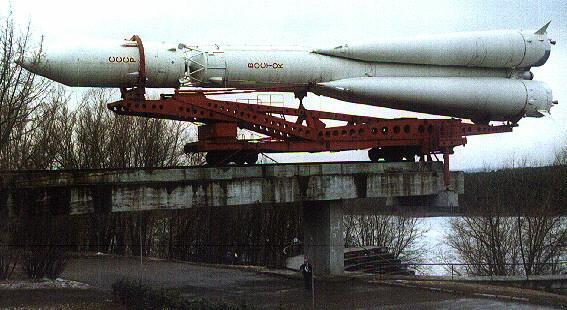
Vostok Kaluga Museum
Credit: © Mark Wade
AKA: 8K72;A-1;Sapwood;SL-3;Vostok. Status: Retired 1960. First Launch: 1960-05-15. Last Launch: 1960-12-01. Number: 4 . Payload: 4,550 kg (10,030 lb). Thrust: 3,873.74 kN (870,851 lbf). Gross mass: 281,375 kg (620,325 lb). Height: 30.84 m (101.18 ft). Diameter: 2.99 m (9.80 ft). Apogee: 200 km (120 mi).
LEO Payload: 4,550 kg (10,030 lb) to a 200 km orbit at 65.00 degrees.
Stage Data - Vostok 8K72
- Stage 0. 4 x Vostok 8K72-0. Gross Mass: 43,300 kg (95,400 lb). Empty Mass: 3,710 kg (8,170 lb). Thrust (vac): 970.000 kN (218,060 lbf). Isp: 312 sec. Burn time: 120 sec. Isp(sl): 254 sec. Diameter: 2.68 m (8.79 ft). Span: 2.68 m (8.79 ft). Length: 19.00 m (62.00 ft). Propellants: Lox/Kerosene. No Engines: 1. Engine: RD-107-8D74. Status: Out of Production.
- Stage 1. 1 x Vostok 8K72-1. Gross Mass: 100,400 kg (221,300 lb). Empty Mass: 6,800 kg (14,900 lb). Thrust (vac): 912.000 kN (205,025 lbf). Isp: 315 sec. Burn time: 310 sec. Isp(sl): 246 sec. Diameter: 2.99 m (9.80 ft). Span: 2.99 m (9.80 ft). Length: 28.00 m (91.00 ft). Propellants: Lox/Kerosene. No Engines: 1. Engine: RD-108-8D75. Status: Out of Production.
- Stage 2. 1 x Vostok 8K72-2. Gross Mass: 7,775 kg (17,140 lb). Empty Mass: 1,440 kg (3,170 lb). Thrust (vac): 49.420 kN (11,110 lbf). Isp: 316 sec. Burn time: 390 sec. Diameter: 2.56 m (8.39 ft). Span: 2.56 m (8.39 ft). Length: 2.84 m (9.31 ft). Propellants: Lox/Kerosene. No Engines: 1. Engine: RD-0105. Status: Out of Production.
More at: Vostok 8K72.
Family: orbital launch vehicle. Country: Russia. Engines: RD-0105, RD-107-8D74, RD-108-8D75. Spacecraft: Vostok. Launch Sites: Baikonur, Baikonur LC1. Stages: Vostok 8K72-0, Vostok 8K72-1, Vostok 8K72-2. Agency: Korolev bureau.
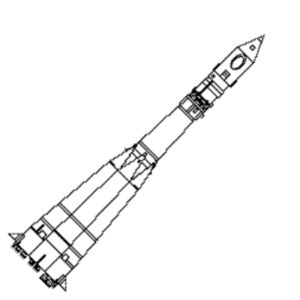 | Vostok LV Credit: © Mark Wade |
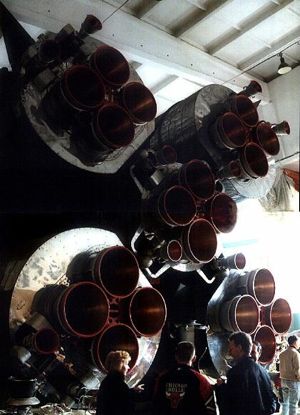 | R-7 aft end Credit: © Mark Wade |
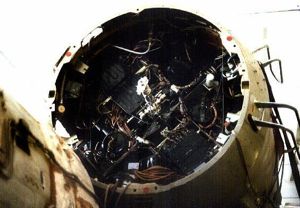 | R-7 forward view R-7 forward compartment Credit: © Mark Wade |
 | R-7 Cutaways Credit: © Mark Wade |
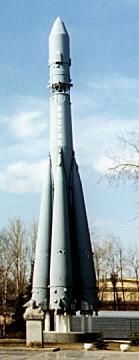 | Vostok Gate Guardian Vostok Gate Guardian at RKK Energia main complex Credit: © Mark Wade |
1956 June - . LV Family: R-7. Launch Vehicle: Vostok 8K72.
- First studies by Korolev OKB of manned spacecraft - . Nation: Russia. Related Persons: Feoktistov, Korolev. Program: Vostok. Class: Manned. Type: Manned spacecraft. Spacecraft: Vostok. First studies by Korolev and Feoktistov of manned spacecraft. The first stage would be suborbital ballistic flights (like the US Mercury-Redstone flights) from Kapustin Yar using IRBM's. First flights not planned until 1964 - 1967..
1958 During the Year - . LV Family: R-7. Launch Vehicle: Vostok 8K72.
- Work begun on Vostok spacecraft and third stage - . Nation: Russia. Program: Vostok. Class: Manned. Type: Manned spacecraft. Spacecraft: Vostok.
1960 May 15 - . Launch Site: Baikonur. Launch Complex: Baikonur LC1. LV Family: R-7. Launch Vehicle: Vostok 8K72.
- Korabl-Sputnik 1 - .
Payload: Vostok 1KP. Mass: 2,500 kg (5,500 lb). Nation: Russia.
Agency: RVSN.
Program: Vostok.
Class: Manned.
Type: Manned spacecraft. Spacecraft: Vostok.
Duration: 1,979.00 days. Decay Date: 1962-09-05 . USAF Sat Cat: 34 . COSPAR: 1960-Epsilon-1. Apogee: 514 km (319 mi). Perigee: 284 km (176 mi). Inclination: 65.00 deg. Period: 92.50 min.
The Soviet Union launched a Vostok 1KP prototype manned spacecraft (without heat shield; not recoverable) into near-earth orbit. Called Sputnik IV by the Western press. On May 19, at 15:52 Moscow time, the spacecraft was commanded to retrofire. However the guidance system had oriented the spacecraft incorrectly and the TDU engine instead put the spacecraft into a higher orbit. Soviet scientists said that conditions in the cabin, which had separated from the remainder of the spacecraft, were normal.
Officially: Development and checking of the main systems of the space ship satellite, which ensure its safe flight and control in flight, return to Earth and conditions needed for a man in flight.
1960 July 28 - . Launch Site: Baikonur. Launch Complex: Baikonur LC1. LV Family: R-7. Launch Vehicle: Vostok 8K72. FAILURE: At ignition one of the combustion chambers in strap on Block B or G burned through. The strap on separated from the core at 17 seconds into the flight and the launch vehicle exploded at 28.5 seconds.. Failed Stage: 0.
- Korabl-Sputnik - . Payload: Vostok 1K s/n 1. Mass: 4,730 kg (10,420 lb). Nation: Russia. Agency: RVSN. Program: Vostok. Class: Manned. Type: Manned spacecraft. Spacecraft: Vostok. Decay Date: 1960-07-23 . First attempted flight of the Vostok 1K manned spacecraft prototype. Dogs Chaika and Lisichka perished in the explosion of the rocket..
1960 August 19 - . 08:44 GMT - . Launch Site: Baikonur. Launch Complex: Baikonur LC1. LV Family: R-7. Launch Vehicle: Vostok 8K72.
- Korabl-Sputnik 2 - .
Payload: Vostok 1K s/n 2. Mass: 1,440 kg (3,170 lb). Nation: Russia.
Agency: RVSN.
Program: Vostok.
Class: Manned.
Type: Manned spacecraft. Spacecraft: Vostok.
Duration: 1.09 days. Decay Date: 1960-08-20 . USAF Sat Cat: 55 . COSPAR: 1960-Lambda-1. Apogee: 340 km (210 mi). Perigee: 281 km (174 mi). Inclination: 64.60 deg. Period: 90.70 min.
The Soviet Union launched its second unmanned test of the Vostok spacecraft, the Korabl Sputnik II, or Sputnik V. The spacecraft carried two dogs, Strelka and Belka, in addition to a gray rabbit, rats, mice, flies, plants, fungi, microscopic water plants, and seeds. Electrodes attached to the dogs and linked with the spacecraft communications system, which included a television camera, enabled Soviet scientists to check the animals' hearts, blood pressure, breathing, and actions during the trip. After the spacecraft reentered and landed safely the next day, the animals and biological specimens were reported to be in good condition.
Officially: Development of systems ensuring man's life functions and safety in flight and his return to Earth.
1960 December 1 - . 07:30 GMT - . Launch Site: Baikonur. Launch Complex: Baikonur LC1. LV Family: R-7. Launch Vehicle: Vostok 8K72.
- Korabl-Sputnik 3 - .
Payload: Vostok 1K s/n 3. Mass: 4,563 kg (10,059 lb). Nation: Russia.
Agency: RVSN.
Program: Vostok.
Class: Manned.
Type: Manned spacecraft. Spacecraft: Vostok.
Duration: 0.99 days. Decay Date: 1960-12-02 . USAF Sat Cat: 65 . COSPAR: 1960-Rho-1. Apogee: 269 km (167 mi). Perigee: 123 km (76 mi). Inclination: 65.00 deg. Period: 88.40 min.
The Soviet Union launched its third spaceship satellite, Korabl Sputnik III, or Sputnik VI. The spacecraft, similar to those launched on May 15 and August 19, carried the dogs Pcheka and Mushka in addition to other animals, insects, and plants. Deorbited December 2, 1960 7:15 GMT. Burned up on reentry due to steep entry angle (retrofire engine did not shut off on schedule and burned to fuel depletion).
Officially: Medical and biological research under space flight conditions.
Officially: Medical and biological research under space flight conditions.
Back to top of page
Home - Search - Browse - Alphabetic Index: 0- 1- 2- 3- 4- 5- 6- 7- 8- 9
A- B- C- D- E- F- G- H- I- J- K- L- M- N- O- P- Q- R- S- T- U- V- W- X- Y- Z
© 1997-2019 Mark Wade - Contact
© / Conditions for Use